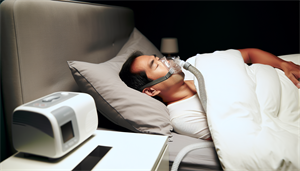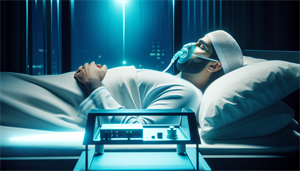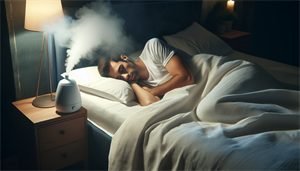Monitoring oxygen levels is a silent guardian of your health during sleep. But what is a dangerously low oxygen level while sleeping?
In this article, we’ll define the critical thresholds you should be aware of and provide you with the know-how to detect and react to these alarming cues—your essential guide to protecting your wellbeing throughout the night.
Key Takeaways
-
Normal oxygen saturation during sleep should range between 95% and 100%, with levels below 92% being concerning, and levels dropping to 88% or lower constitute a medical emergency.
-
Sleep-related breathing disorders, particularly sleep apnea, along with other respiratory conditions such as COPD and heart failure, are significant contributors to dangerously low oxygen levels while sleeping.
-
Monitoring oxygen levels during sleep can be done using a pulse oximeter or home sleep tests, and treatment options include CPAP therapy, lifestyle changes, and managing underlying health conditions.
Understanding Oxygen Levels During Sleep

Oxygen saturation, also known as blood oxygen levels, significantly reflect your health status. During sleep, these levels can fluctuate due to a variety of factors. Just like a well-orchestrated symphony, our bodies have a natural rhythm that governs our breathing and oxygen intake during sleep. This orchestra, however, can sometimes hit a sour note, leading to drops in oxygen levels that can have significant health implications.
There are numerous factors that can result in sleep-related hypoxemia, which is marked by decreased oxygen levels during sleep. Some potential culprits include:
-
High altitudes
-
Limited oxygen availability in the air
-
Respiratory conditions like COPD, emphysema, and bronchitis
-
Sleep apnea
-
Lung diseases
-
Heart disease
-
Pneumonia
-
Asthma
All of these issues can contribute to a decrease in blood oxygen levels during sleep.
Normal Ranges
So, what should your blood oxygen levels be during sleep? The typical range for normal oxygen levels is between 95% and 100%. However, if your blood oxygen level drops below 92%, it’s time to sit up and take notice because your body might not be getting the oxygen it needs to function optimally. If it drops to 88% or lower during sleep, it constitutes a medical emergency requiring immediate attention.
Sustaining these levels goes beyond merely ticking a box. It’s about ensuring your body gets the oxygen it needs. Red blood cells are the highway for oxygen in our body, transporting it from our lungs to our tissues. When oxygen levels falter, our bodies have to work harder to deliver enough oxygen to our cells. It’s a bit like trying to run a marathon with a backpack full of rocks.
So, keeping an eye on your oxygen levels during sleep isn’t just about numbers on a screen - it’s about safeguarding your health.
Factors Affecting Blood Oxygen Levels
Understanding what affects your oxygen levels during sleep can help you take control. For instance, did you know that the higher you go, the harder it is for your body to get the oxygen it needs? That’s because high altitudes have less oxygen in the environment, which can lead to insufficient oxygen intake and potential hypoxemia.
Underlying medical conditions can also significantly impact your oxygen levels. Lung diseases can lead to hypoventilation, a condition where not enough oxygen enters the lungs, and the blood vessels that transport it to the rest of the body. Other conditions causing right-to-left shunting can also result in low blood oxygen levels during sleep.
Identifying Dangerously Low Oxygen Levels

Comprehending oxygen levels is vital, yet it’s equally essential to identify when they dip to perilously low levels. Imagine driving a car with a broken fuel gauge. You wouldn’t know when to refill the tank until the car stopped running. Similarly, if you don’t recognize the signs of low oxygen levels, your body could be running on empty without you knowing.
When oxygen levels drop below the body’s necessary requirements for normal functioning, it’s known as oxygen desaturation. Indicators of dangerously low oxygen levels during sleep include:
-
Rapid heartbeat
-
Discomfort or pain in the chest
-
Bluish tint on lips, face, or nails
-
Confusion
-
Lightheadedness
-
Elevated blood pressure
These symptoms indicate insufficient oxygen intake by the body, and if a person’s blood oxygen level, also known as blood oxygen saturation, dips below 92%, it’s deemed critical. If blood oxygen levels drop to 88% or lower, it constitutes a medical emergency requiring immediate attention.
Signs and Symptoms
Decreased oxygen levels during sleep can manifest in subtle ways. You might notice:
-
Shortness of breath
-
A rapid heart rate
-
Difficulty breathing
-
Snoring
One telltale sign of lung disease is cyanosis, a bluish discoloration of the skin due to low oxygen levels in your blood.
Apart from these physical symptoms, low oxygen levels can also lead to mental changes such as confusion. This is because our brains are particularly sensitive to changes in oxygen levels. In fact, a morning headache could be your body’s way of telling you that your oxygen levels dropped during sleep.
Hence, identifying these signs and symptoms can serve as the initial step towards addressing decreased oxygen levels during sleep.
When to Seek Help
Knowing when to seek medical help is crucial when dealing with low oxygen levels. An oxygen level below 88% is considered critical due to hypoxemia, which can pose a threat to vital organs. If you encounter severe symptoms like:
-
headache
-
difficulty breathing
-
rapid heart rate
-
bluish skin during sleep
It’s time to seek medical help.
The consequences of not seeking help can be severe. Failing to address low oxygen levels during sleep can result in immediate complications such as:
-
headaches
-
breathing difficulties
-
rapid heart rate
-
bluish skin
-
excessive daytime sleepiness
-
adverse effects on heart health
Moreover, if hypoxemia remains untreated, it can cause long-term damage to vital organs such as the heart and brain, and in severe cases, it can be fatal.
Causes of Low Oxygen Levels While Sleeping

Having understood the appearance of low oxygen levels and their associated risks, it becomes essential to discern their potential causes. Conditions such as sleep apnea, sleep-related hypoventilation, and even certain medications can lead to decreased oxygen levels during sleep. If these conditions don’t explain the decrease in oxygen levels, it could result in a condition known as sleep-related hypoxemia.
Conditions that can cause decreased oxygen levels during sleep include:
-
Sleep apnea, a condition where relaxed throat muscles interfere with normal breathing, can cause blood oxygen levels to drop by 3% or more, resulting in oxygen desaturation.
-
Chronic obstructive pulmonary disease (COPD)
-
Heart failure
-
Various valve diseases
-
Neuromuscular conditions
-
Complications due to obesity
Sleep Apnea
Sleep apnea, a type of sleep related breathing disorder, is a potentially serious sleep disorder characterized by repetitive pauses in breathing. It comes in three types:
-
Obstructive sleep apnea (OSA): impacts oxygen levels during sleep by causing frequent breathing gaps. These are caused by relaxed throat muscles interfering with normal breathing, resulting in blood oxygen levels dropping by 3% or more.
-
Central sleep apnea: occurs when the brain fails to send the proper signals to the muscles that control breathing.
-
Complex sleep apnea: a combination of obstructive and central sleep apnea.
Common signs of sleep apnea during sleep consist of:
-
Loud snoring
-
Waking up with a sore or dry throat
-
Dry mouth
-
Occasional gasping or choking
The condition can lead to decreased oxygen levels during sleep, which can affect overall oxygen saturation as a result of breathing interruptions.
Central sleep apnea can result in low oxygen levels due to the failure of respiratory control mechanisms, resulting in upper-airway collapse and the absence of the wakefulness drive to breathe.
Other Respiratory Disorders
Apart from sleep apnea, other respiratory conditions can also cause low oxygen levels during sleep. Chronic obstructive pulmonary disease (COPD) can result in temporary nighttime desaturation, which can cause a decrease in blood oxygen levels during sleep. Common symptoms of COPD include:
-
Breathing difficulties
-
Coughing
-
Mucus production
-
Wheezing
-
Shortness of breath
-
Chest discomfort
Heart failure is another condition that can affect oxygen levels during sleep. Sleep apnea, a condition characterized by interrupted breathing during sleep, has been associated with several cardiovascular diseases, including heart failure. Elderly men who experience extended episodes of interrupted breathing while asleep also have a high risk of heart problems.
Monitoring and Measuring Blood Oxygen Levels
As observed, maintaining stable blood oxygen levels during sleep is paramount for maintaining good health. But how can we know if our oxygen levels are within the normal range? Enter pulse oximeters and home sleep tests, two valuable tools for monitoring and measuring blood oxygen levels. These devices provide a way for individuals to keep tabs on their oxygen levels, empowering them to take control of their health.
A pulse oximeter is an electronic instrument designed to measure the saturation of oxygen carried in red blood cells. This device operates by:
-
Emitting light at two different wavelengths through a translucent part of the body, such as a fingertip or earlobe
-
Calculating the oxygen saturation by detecting the amount of light that passes through
-
Detecting the differences in light absorption between oxygenated and deoxygenated blood.
Pulse Oximeters
Pulse oximeters are non-invasive medical devices designed to measure blood oxygen levels using a fingertip or earlobe sensor. They utilize a cold light source to shine light through the fingertip, causing the tip to appear red. By analyzing the light passing through the finger, the device can ascertain the percentage of oxygen in the red blood cell.
Pulse oximeters demonstrate the highest precision when blood oxygen saturation falls within the range of 90% to 100%. Typically, prescription oximeters exhibit a precision level that deviates by approximately 4% from a given reading. However, their accuracy decreases below these levels, with the least accuracy observed when oxygen saturations are under 80%.
Home Sleep Tests
Home sleep tests are another tool for monitoring oxygen levels during sleep. These tests typically use devices such as:
-
Pulse oximeters
-
Recording devices
-
Nasal cannula or nasal prongs
-
Snoring sensors
They measure heart rate, breathing, and oxygen saturation. In some cases, a plastic clip known as an oximeter is applied over the end of the finger as part of the testing process.
Home sleep tests do have their limitations. While they can monitor breathing and oxygen levels during sleep, they may not offer as thorough data as overnight sleep studies. However, they are valuable for identifying low oxygen levels and can be recommended by physicians for evaluating sleep quality and oxygen levels.
To achieve precise outcomes with home sleep test devices, it’s advisable to maintain sleeping positions on your back and side and to meticulously adhere to the testing instructions to accurately place the required sensors.
Treatment Options for Low Oxygen Levels During Sleep

Dealing with low oxygen levels during sleep involves more than just pinpointing the issue - it’s about discovering a resolution. The available treatments for low oxygen levels during sleep are contingent on the root cause. In the context of sleep apnea, these treatments focus on ensuring continuous breathing and sufficient oxygen levels throughout the night.
Established treatments for sleep apnea encompass:
-
Supplemental oxygen
-
Continuous Positive Airway Pressure (CPAP)
-
Bi-level Positive Airway Pressure (BPAP)
-
Adaptive servo-ventilation (ASV)
A crucial aspect is CPAP therapy, which entails using a mask linked to a machine that delivers a continual stream of air to maintain airway patency during sleep. Surgical interventions for sleep apnea may include procedures such as laser or cautery-assisted uvulopalatoplasty (LAUP).
Sleep Apnea Treatments
Continuous positive air pressure (CPAP) therapy is widely recognized as the most effective treatment for adults suffering from obstructive sleep apnea. CPAP therapy involves:
-
wearing a mask over your nose and/or mouth while you sleep
-
the mask is connected to a machine that delivers a continuous stream of air into the nose
-
this prevents the airways from collapsing, which helps to maintain a steady level of oxygen in the blood.
Positional devices and nasal steroids can also be used to treat sleep apnea. Positional devices are used to maintain individuals in a side or stomach position during sleep, helping to maintain an open airway and reduce occurrences of apnea. Nasal steroids can be beneficial if breathing during sleep is impacted by allergies, as they can help reduce inflammation and open up the airways, improving oxygen levels.
Lifestyle Changes
Modifications in lifestyle can also substantially contribute to the enhancement of oxygen levels during sleep. Maintaining a healthy weight can enhance oxygen levels during sleep by mitigating the risk of sleep apnea and obesity hypoventilation syndrome, both of which can contribute to decreased blood oxygen levels. Regular exercise contributes to the improvement of oxygen levels during sleep by enhancing the body’s ability to efficiently intake oxygen into the bloodstream and deliver it to the muscles.
Other lifestyle changes that can improve oxygen levels during sleep include abstaining from alcohol and sedatives, which can decrease the likelihood of sleep apnea and promote regular breathing patterns. Maintaining good sleep hygiene can significantly enhance oxygen levels during sleep, particularly for individuals with sleep-related breathing disorders such as sleep apnea.
Summary
In conclusion, understanding and monitoring your blood oxygen levels during sleep is an essential aspect of maintaining good health. Low oxygen levels during sleep can lead to a range of health issues, from mild symptoms such as headaches and confusion to severe complications like heart failure and other life-threatening conditions.
Recognizing the signs of low oxygen levels, understanding the potential causes, and knowing how to monitor these levels at home are crucial steps in managing your health. Whether it’s through lifestyle changes, the use of devices like pulse oximeters, or seeking medical treatment for conditions like sleep apnea, there are many ways to ensure that your body gets the oxygen it needs during sleep. Remember, knowledge is the first step to action. Equip yourself with the right information, and take control of your health today.
Frequently Asked Questions
How low is too low for oxygen while sleeping?
Oxygen levels below 90% during sleep can be concerning and may indicate a potential health issue. It's important to consult a healthcare professional if you have concerns about your oxygen levels.
What are the symptoms of low oxygen at night?
Seek medical attention if you experience symptoms of low oxygen at night, including:
At what point should you go to the ER for low oxygen?
You should go to the ER for low oxygen if your oxygen saturation levels drop below 92%, and seek immediate medical attention if they fall to 88% or lower. It is essential to address this as soon as possible to prevent complications.
How low can oxygen level get before it is fatal?
Oxygen levels below 15 percent can lead to serious symptoms of hypoxia, putting the individual at risk of serious injury or even death. Values under 70% are considered life-threatening.
Related health topics?
You can explore various health topics for valuable information on overall well-being.


